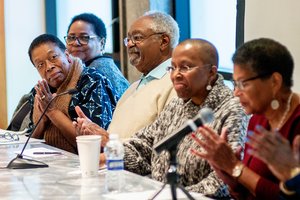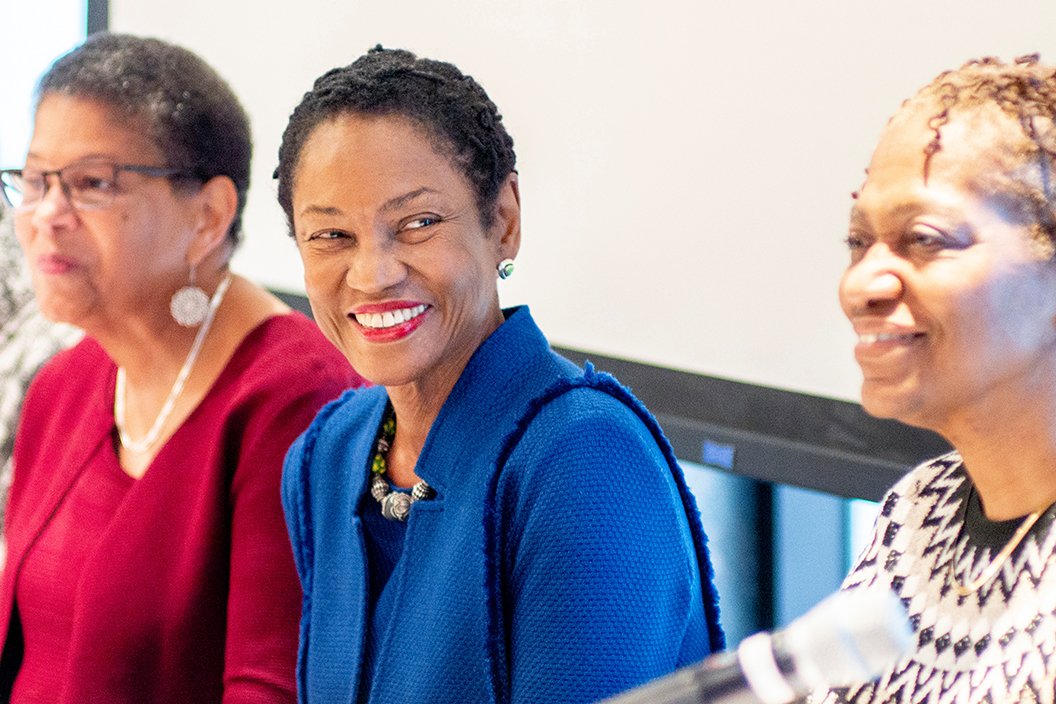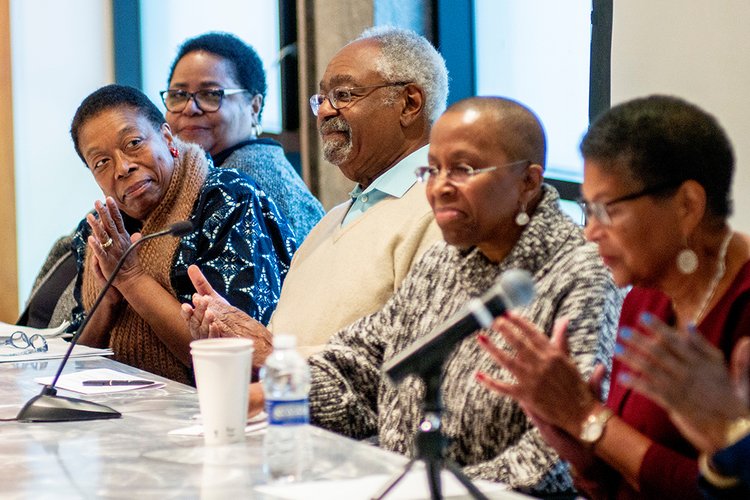Listen: 'Seven Sisters and a Brother' Authors Tell Story of Student Takeover that Paved Way for More Inclusive Swarthmore
'Seven Sisters and a Brother' Panel


From left: Joyce Baynes '68, Marilyn Holifield '69, and Marilyn Allman Maye ‘69
Seven of the eight authors of Seven Sisters and a Brother: Friendship, Resistance, and Untold Truths Behind Black Student Activism in the 1960s returned to campus last month to share their reflections on a tumultuous and transformative time at the College — including the eight-day takeover of the Admissions Office they organized in 1969. Their actions at the time came in response to the low numbers of Black students on campus and to the insensitivity and lack of administrative support they experienced.
“The activism of these courageous alumni paved the way for future generations of Swarthmore students,” President Valerie Smith said in her opening remarks. “At great risks to themselves, they fought for justice at the College and forever changed our trajectory.”
During their talk in a packed Scheuer Room, the alumni described their backgrounds and what drew them to Swarthmore. They also recounted the “tipping point” for Black student frustrations: the College’s refusal to remove from McCabe Library a report containing their personal information. Intended to describe the state of Black admissions at the College, the report contained Black students’ SAT scores, their Swarthmore grades, family incomes and occupations, and academic standing.
“We thought that was a breach of trust,” said Marilyn Holifield ’69, a partner at Holland & Knight LLP and member of the Board of Managers. “That motivated us to just say, ‘Enough is enough, something has to change.’"
Despite repeated requests, the authors said they never received a satisfactory explanation for why the report in McCabe could not be removed. "We don't really know the answer to that question," Holfield said. "That mystery remains unsolved."

From left: Aundrea White Kelley ‘72, Myra E. Rose '70, Harold Buchanan '69, Jannette Domingo ‘70, and Joyce Baynes '68.
The authors noted that they also never received an apology from the College for publishing the report. But during the Q&A period, President Smith raised her hand to address the panel.
"As I reflect on the impact of the report on you all as students, what it meant to have that document in the library knowing that your privacy was violated and that you were disrespected, it's actually heartbreaking," Smith said. "And so I, on behalf of the College, want to apologize to you for the fact that you had to endure that. I realize that this apology is belated, but it is heartfelt and I am truly sorry for the harm that it caused you."
The apology drew applause from the crowd, and acceptance from the authors.
“On behalf of the Black community of Swarthmore that was here in 1969, and the Black community that has evolved over the years, we are deeply grateful for this apology,” Holfield said.
Harold Buchanan '69, who retired from Wyeth Pharmaceuticals, added that their relationship with the College has vastly improved and wanted everyone to know: “Because of the way the College has welcomed and received us, our share of the proceeds from the book are being donated to the College for Black Studies in support of the Black community here.”
Alumni Reflections
Joyce Frisby Baynes ’68, M.Ed. in mathematics administration and Ed.D. in mathematics education, Columbia University; MAT, Harvard University; retired superintendent, Dunellen and Englewood, N.J., school districts
"I was really mesmerized by McGill Walk, the Rose garden, Parrish Hall. It just was so incredibly beautiful. And I knew nothing about the financial demands. I knew nothing about the academic rigor. I just said I want to go to Swarthmore, and lo and behold, that year, 1964, is when the college got a very large grant from the Rockefeller Foundation to try to integrate the school. Before my class came in, there were only 10 black students on the whole campus. My class brought about another dozen, so we doubled just that year, 1964-65. So I came to Swarthmore really unaware of the demands and unaware of the kind of social milieu there was here. And so I basically was incredibly lonely. And that's what I endured for the first year until many of my sisters came, and Harold Buchanan ['69], and we began to collectively feel, wow, we can at least bond together and see what it is that we all need and ask the college to listen to us. And then that's where we went from there."
Harold Buchanan ’69, M.Ed., Temple University; retired associate director of information systems, Wyeth Pharmaceuticals
"When I came to Swarthmore and met this group of educated blacks, it was a new experience for me to be able to communicate and discourse with them. And my class was about 20 blacks in our class, and we again doubled the black population. So I learned about blackness in associating with black peers at the college. And by sophomore year, I was converted to being black, and the story I tell is in the '60s, they called the people like me Oreos, black on the outside and white on the inside. But by sophomore year, I was fully black and there was no turning back."
Jannette Domingo ’70, M.A. in economic development, McGill University; and M.Phil. and Ph.D. in economics, Columbia University; professor emerita, retired dean of graduate studies, and former chair of Department of African American Studies, John Jay College of Criminal Justice
"Coming to Swarthmore was not that different, I felt, from being at Hunter College High School, in terms of the rigor, in terms of the social environment, being one where there were very few black students. At Hunter College High School, there was six black students in my graduating class. So I did not expect more than that at Swarthmore, but I got more in the sense that we'd live together and were able to create bonds and to exert an influence that high school students who went home every day to their parents were not able to do at our institution."
Marilyn Holifield ’69, J.D., Harvard University; partner, Holland & Knight LLP; member, Swarthmore College Board of Managers, Harvard University Board of Overseers, and University of Miami Board of Trustees
"My coming to Swarthmore was somewhat fortuitous. I had an older brother who was at nearby Franklin and Marshall College, and I learned that the director of financial aid here, his father and my brother were classmates at Franklin and Marshall. My brother had a friend who lived in the town of Swarthmore, and he bragged to this friend about his little sister. So the way I tell the story is that they made a bet: If your sister is all what you say she is, have her apply to Swarthmore and see if she can get in. I had no idea that it was this friend and this I guess male competition over something that led my brother to say, Marilyn, Swarthmore is a great school. It's co-ed. At that time, Franklin and Marshall was all male, and the Quakers founded it, and you know the Quakers are very liberal. It'd be a great experience. And I applied, I got in, he won the bet. And the rest is history."
Aundrea White Kelley ’72, MBA and M.S. in public policy, University of Massachusetts Boston; former commissioner, Massachusetts Board of Higher Education; retired chief academic officer, Quincy College
"[Swarthmore] reminded me of summer camp. Everything was green and lush, and I just had to come there. I went to my guidance counselor. She had not told me about Swarthmore, mind you. I had seen a poster. It was actually one of these big postcards on the bulletin board outside the guidance counselor's office. And so I was all excited, and I said I found the place I wanted to go. And she said, "Well, you'll never get in. Don't apply." And so like any good teenager, I applied and ended up here. Another thing about Swarthmore that attracted me was the fact that it was a Quaker college. I had grown up in a Christian home, spent probably 80% of my time in church doing various activities and participating in various programs. I spent a lot of time also in community events. There were a number of significant community activists in Boston at the time that developed programs, arts programs and so forth. And I enjoyed that as well. And I was attracted to the fact that Swarthmore was also close to Philadelphia, so I might be able to continue some of those activities here."
Marilyn Allman Maye ’69, M.A. in mathematical statistics and Ed.D. in education, Columbia University; MAT in mathematics, Harvard University; retired associate professor of educational leadership, New Jersey City University
"I was born and raised in Harlem, in New York city, the daughter of a working-class family. My parents were both immigrants. They came to New York in the early 1910s, 1920s, and was raised in a church in my community in Harlem where we were taught strong values of standing up for what you believe and being courageous, having moral courage I suppose. And I was always very curious. I think curiosity describes me. I was curious about who I was. It was never taught. I could never find the places where my parents came from on any maps. They were never in school. I couldn't ever find out where those places were. And it was nothing about my history, and I didn't understand the neighborhood and the different ethnic groups that were there. And I came to Swarthmore and found they had just started a sociology and anthropology department here. I was thrilled and signed up for that."
Myra E. Rose ’70, M.D., Tufts University; former internal medicine residency program director, hospice medical director, and chair of medicine, Morehouse School of Medicine
"I'm sitting in the guidance counselor's office, and there was a catalog on the table. And it was garnet, I guess that's the color, garnet and white or something, or red and white or whatever. Anyway, it looked nice and I picked it up, and I was just thumbing through the catalog and looking, and I said, "Oh, that looks nice. I think I'll go ahead and apply." I really believe that I've been directed, seriously, to do this, because I never saw Swarthmore. No one in my family had heard of Swarthmore. No one in my school had heard of Swarthmore. As far as I knew, nobody in Norfolk had heard of Swarthmore. So I applied there, I applied to the University of Pennsylvania, a few other schools, and several HBCUs, and I got in everywhere. And what happened was that it all came down to the money. Swarthmore got me because I got a full scholarship and $200 for books. It was the $200 for books. Seriously. And so I came to Swarthmore."
[Not in attendance on Feb. 21] Bridget Van Gronigen-Warren ’70, M.S. and Ph.D., medical microbiology and immunology, Temple University; retired professor of biology, University of Panama; retired professor of microbiology and immunology, University of Panama medical school; retired microbiologist, water quality unit, Panama Canal Authority


